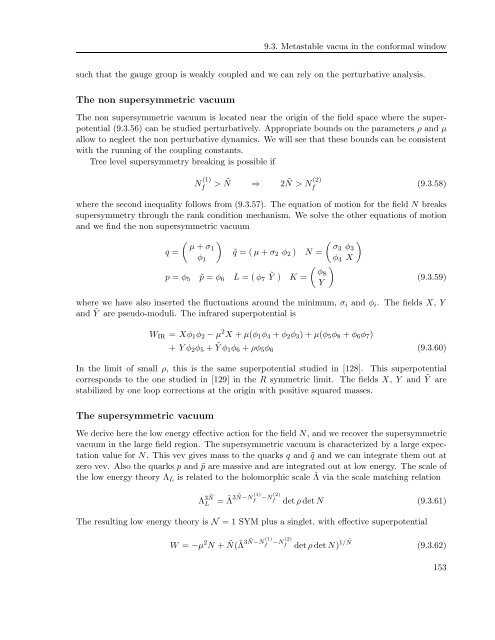Perturbative and non-perturbative infrared behavior of ...
Perturbative and non-perturbative infrared behavior of ...
Perturbative and non-perturbative infrared behavior of ...
Create successful ePaper yourself
Turn your PDF publications into a flip-book with our unique Google optimized e-Paper software.
9.3. Metastable vacua in the conformal window<br />
such that the gauge group is weakly coupled <strong>and</strong> we can rely on the <strong>perturbative</strong> analysis.<br />
The <strong>non</strong> supersymmetric vacuum<br />
The <strong>non</strong> supersymmetric vacuum is located near the origin <strong>of</strong> the field space where the superpotential<br />
(9.3.56) can be studied <strong>perturbative</strong>ly. Appropriate bounds on the parameters ρ <strong>and</strong> µ<br />
allow to neglect the <strong>non</strong> <strong>perturbative</strong> dynamics. We will see that these bounds can be consistent<br />
with the running <strong>of</strong> the coupling constants.<br />
Tree level supersymmetry breaking is possible if<br />
N (1)<br />
f<br />
> Ñ ⇒ 2Ñ > N(2)<br />
f<br />
(9.3.58)<br />
where the second inequality follows from (9.3.57). The equation <strong>of</strong> motion for the field N breaks<br />
supersymmetry through the rank condition mechanism. We solve the other equations <strong>of</strong> motion<br />
<strong>and</strong> we find the <strong>non</strong> supersymmetric vacuum<br />
<br />
µ + σ1<br />
q = ˜q = ( µ + σ2 φ2 ) N =<br />
φ1<br />
p = φ5 ˜p = φ6 L = ( φ7 ˜ <br />
φ8<br />
Y ) K =<br />
Y<br />
<br />
σ3 φ3<br />
φ4 X<br />
<br />
(9.3.59)<br />
where we have also inserted the fluctuations around the minimum, σi <strong>and</strong> φi. The fields X, Y<br />
<strong>and</strong> ˜ Y are pseudo-moduli. The <strong>infrared</strong> superpotential is<br />
WIR = Xφ1φ2 − µ 2 X + µ(φ1φ4 + φ2φ3) + µ(φ5φ8 + φ6φ7)<br />
+ Y φ2φ5 + ˜ Y φ1φ6 + ρφ5φ6<br />
(9.3.60)<br />
In the limit <strong>of</strong> small ρ, this is the same superpotential studied in [128]. This superpotential<br />
corresponds to the one studied in [129] in the R symmetric limit. The fields X, Y <strong>and</strong> ˜ Y are<br />
stabilized by one loop corrections at the origin with positive squared masses.<br />
The supersymmetric vacuum<br />
We derive here the low energy effective action for the field N, <strong>and</strong> we recover the supersymmetric<br />
vacuum in the large field region. The supersymmetric vacuum is characterized by a large expectation<br />
value for N. This vev gives mass to the quarks q <strong>and</strong> ˜q <strong>and</strong> we can integrate them out at<br />
zero vev. Also the quarks p <strong>and</strong> ˜p are massive <strong>and</strong> are integrated out at low energy. The scale <strong>of</strong><br />
the low energy theory ΛL is related to the holomorphic scale ˜Λ via the scale matching relation<br />
Λ 3Ñ<br />
L = ˜ Λ 3Ñ−N(1)<br />
f −N(2)<br />
f detρdet N (9.3.61)<br />
The resulting low energy theory is N = 1 SYM plus a singlet, with effective superpotential<br />
W = −µ 2 N + Ñ(˜ Λ 3Ñ−N(1)<br />
f −N(2)<br />
f detρdet N) 1/Ñ<br />
(9.3.62)<br />
153
















